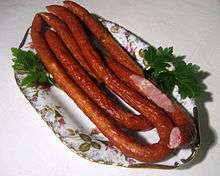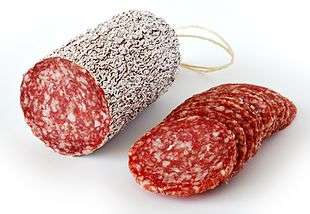Kabanos
 | |
| Type | Sausage |
|---|---|
| Course | Appetizer, main |
| Place of origin | Poland |
| Serving temperature | Hot, Cold |
| Main ingredients | Pork |
Kabanos (/kəˈbænəs/; plural: kabanosy) is a Polish, long, thin, dry sausage made of pork or beef. They are smoky in flavor, and can be soft or very dry in texture depending on freshness. Typically, they are quite long, 60 cm (24 in), but very thin, with a diameter around 1 cm (0.39 in), and folded in two, giving them a characteristic appearance.
Etymology and history
The name comes from the word kaban, an old term used in Eastern Poland for a young male pig fattened with potatoes specially for making this kind of sausage (hence kabanos - "made of kaban"). The word kaban with a similar meaning is also present in other Slavic languages, e.g. it denotes a boar in Russian and Ukrainian. It was loaned into Slavic from Turkic languages.[1]
Kabanosy are known to have been produced since medieval times at least, and because of their long-lasting capabilities they were considered perfect food for soldiers and travellers, which is reflected by kabanos' design traits: thinness, usually very extended length, and shape in which they are always kept. According to some historians, they were hung around neck (like a necklace), allowing any horse-mounted riders to eat on the go without stopping for a food break. For the same reason, they were also used as hiking food and are very common among Polish Highlanders. Tighter, smaller wraps of long kabanosy - as sold nowadays - were also common among foot soldiers (and travellers). Smaller kabanos wrapping allowed it to be "worn" on a wrist and eaten while marching.
Nowadays, kabanosy are made using different spices, and come in many different flavours. Before the 20th century, various spices were also being used in the production of kabanosy, giving them locally distinct tastes, which differed between various regions of Poland.
Modern times
Production of kabanosy requires minimum of 150 grams of best grade pork meat to make 100 grams of sausage, which is known today as "minimum of 3:2 ratio". It happens because of the loss of some of the water contained within meat used to prepare the raw sausage, which evaporates during the long process of meat smoking.[2] Nowadays almost every Polish manufacturer of kabanosy describes on the packaging at which ratio their sausage was made, for example manufacturer Kania states that "157 grams of meat was used to make 100 grams of kabanosy".[3]
The two main types of kabanosy include a slightly "softer" and more common type (smoked much less, just for the taste), and "harder" ones (much drier than the softer ones), which are smoked for very long time, basically until bending the sausage becomes difficult (to the point that it cracks when someone attempts to bend it). Because of the long and thorough smoking process, the "harder kabanos" type is extremely long-lasting and does not spoil as quickly as most other meats without preservatives. Furthermore, kabanosy are also categorized into another two main types, depending on the amount of spices: "hot" (very spicy) and "mild" (less spicy). Both "harder" and "softer" types of kabanosy come as "hot" or "mild", since the "hardness" of sausage come only from the length of smoking times, but otherwise they are made of the same ingredients.
According to modern recipe, kabanosy are currently seasoned with different spices, such as black pepper, chilli, and others. Unlike other meats, these sausages are typically eaten alone as an appetiser and often served with cheese. Although kabanosy can be cooked with other food, they are usually served cold only. Only if no other meat was available to Polish travelers or soldiers would they then have sliced kabanos into small pieces to cook them with vegetables, buckwheat, millet, potatoes, or whatever else was available.
In recent years, some manufacturers created sausages made according to the same process as kabanosy, but substituted pork with other meat (mainly poultry). Due to their distinct shape and look, they are often called kabanosy, too, with the addition of name of the meat they contain, e.g. kabanosy z kurczaka, "chicken kabanosy".
Polish-German dispute
After Polish accession to the European Union, Poland and Germany fought a trade war for 10 years over the name kabanos (due to a German claim to the traditional Polish recipe).[4] In 2011, when Polish manufacturers submitted scientific proofs of kabanos' Polish origins from their historians, the EU finally granted the Guaranteed Traditional Speciality kabanos name to Poland.[5] This status does not forbid manufacturers from other countries to produce and sell kabanos under that name, but demands that it is made according to specified "time-honoured recipes."[6]
See also
References
- ↑ Max Vasmer (1953–1958). "Кабан". Russisches etymologisches Wörterbuch (in German). Heidelberg: Winter. Russian translation by Oleg Trubachyov: "Кабан". Этимологический словарь русского языка. Moscow: Progress. 1964–1973.
- ↑ "Kabanosy - tradycyjny specjał z Polski". Prawdziwe Mistrzostwo. Retrieved 1 November 2015.
- ↑ "ZM Kania - Kabanosy". Zakład Mięsny Kania. Retrieved 1 November 2015.
- ↑ "Polish-German War Over Kabanosy". TVN24. 30 August 2010. Retrieved 1 November 2015.
- ↑ "Poland has won the war over Kabanosy". TVP Info. 22 September 2011. Retrieved 1 November 2015.
- ↑ Stratis G. Camatsos (27 Sep 2011). "Kabanos sausages obtain EU certification. Germany withdraws its objection". NewEurope.
